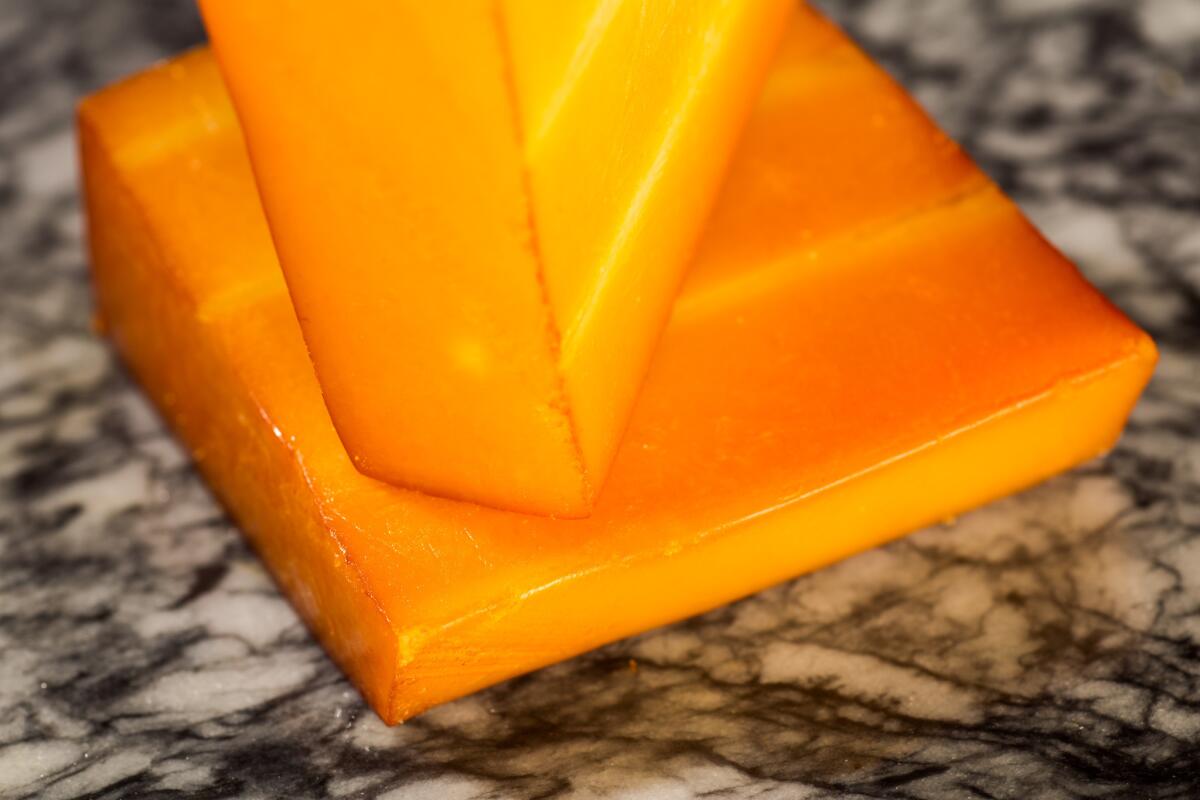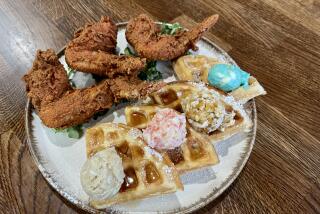Smoking, hot or cold, can add flavor to nearly any food

Smoked Cheese, photographed in the Los Angeles Times Test Kitchen on May 13, 2015.
- Share via
There’s a primal wonder to smoked food — that such depth of flavor can come from so simple a technique. And then there’s the fun of the process itself, whether you’re working with a formal smoker setup or one you’ve “MacGyver-ed” out of odds and ends. Because, with a little creativity, you can smoke almost anything.
As for flavor, there’s more to it than mere “smokiness.” You’ll find a great variety of character depending on the type of wood used and its intensity. Woods range from assertive hickory to delicate apple. Cherry is pronounced and pecan lends a fragrant nuttiness. Mesquite can be either delicately sweet or overwhelmingly assertive, depending on how (and how much) it’s used. It’s not hard to find alder (popular in the Northwest) or corncob (possibly best known in the Northeast). Or try flavored hardwoods — wine casks, maybe, or bourbon-soaked oak.
You don’t even need to smoke with wood at all. Try tea or seaweed, or rice, nut shells and aromatics, such as spices, herbs and citrus peel.
And where meat is probably the most traditional of smoked foods, flavoring options are almost endless, from nuts, fruit, yogurt and cheeses. Imagine having a cocktail with smoked ice.
In the Kitchen: Sign up for our weekly cooking newsletter
Think smoking, and the first type of smoking that comes to mind is hot-smoking: using smoke over high heat to both cook and flavor foods, including brisket, ribs, chicken and sausages.
Cold smoking is similar to hot smoking but without the heat. This type of smoking is strictly about flavor.
When cold-smoking, smoke is typically transmitted from one chamber to another over a distance, so the food is flavored but not cooked. This is generally done for much longer, from a couple of hours up to a day or more. Because of this, cold-smoked food is previously cooked or preserved in some way — whether fermented, pickled or cured — so it doesn’t go bad as it smokes.
To create a cold smoker, attach a tube of some sort from your hot smoker to a separate chamber. An online search will reveal a lot of creative ideas, including using dryer vent tubes and pipes. You can also use a single-chamber smoker provided the smoke source doesn’t generate too much heat and the temperature stays cool.
If you’re doing something simple, like cheese, a basic box smoker will work on a chilly morning, when the outdoor temperature will help keep the chamber cool.
Before smoking, refrigerate the cheese uncovered the night before so it develops a “pellicle” — that sticky surface to which the smoke will adhere. For smoked applewood Comte, place small wedges (no thicker than 2 inches) of cheese on a rack toward the top of the smoker, and place a tray of ice above and underneath the cheese to keep it cool. Wood pellets work well here; a small tray of pellets can smolder for hours, generating lots of flavorful smoke.
Check the cheese occasionally to make sure it stays cool; if the cheese starts to sweat, the heat is too high. After just a couple of hours, the pale yellow cheese will have achieved a rich amber color and that telltale smoky perfume. Wrap it tightly and refrigerate it; the smokiness will mellow with time.
The cheese is perfect folded into omelets or other dishes, or simply sliced as part of a cheese tray.
But because it’s such a great melting cheese, try making a grilled cheese sandwich with it, perhaps the smoked Comte is best as part of a grilled cheese sandwich, nestled between two thick slices of rustic country loaf with a few marinated summer tomato slices wedged in for good measure.
::
A-Maze-N tray works well for cold smoking
When you’re looking to rig a simple cold smoker, it doesn’t get much easier than A-Maze-N’s maze tray, a durable and portable smoke generator. Fill the lightweight 8-by-5-inch tray with wood pellets (the manual says sawdust can also be used), and light the pellets at one end with a small propane torch or gelled alcohol. Once the wood is burning, blow out the flame and the wood will continue to smolder, generating smoke. The perforated metal tray is separated into three connected rows, and each row will smoke three to four hours during cold smoking, and two to three hours at a temperature of 225 degrees. Fill the entire tray with 1 pound of pellets and it will smoke about 11 hours. The tray also works in hot smokers and has been tested at temperatures up to 275 degrees. A-Maze-N also carries various wood pellets for use with the tray.
Find the tray and wood pellets at select barbecue and cooking stores, as well as online for about $35. Wood pellet prices vary by weight and brand.
More to Read
Eat your way across L.A.
Get our weekly Tasting Notes newsletter for reviews, news and more.
You may occasionally receive promotional content from the Los Angeles Times.











